Can the Establishment of National Key Ecological Function Areas Enhance Vegetation Carbon Sink? A Quasi-Natural Experiment Evidence from China
Abstract
:1. Introduction
2. Literature Review and Theoretical Analysis
- (1)
- NKEFAs can optimize the pattern of territory development. The NKEFAs expand ecological space, clearly restrict large-scale and high-intensity urbanization and industrialization, and strictly control the development intensity and scope in the territory development according to the carrying capacity of regional resources and environment [24]. Urban construction and industrial development should be concentrated, and stronghold-type development in existing towns with relatively strong carrying capacity of resources and environment requires the full delineation of ecological red lines. The delineation of restricted development areas and ecological red lines promotes the optimization of territorial spatial development pattern, improves the efficiency of land spatial allocation [25], and maintains ecological function while minimizing restrictions on human land use [26].
- (2)
- NKEFAs can promote industrial structure upgrading. The negative list of industrial access in NKEFAs clarifies the list of industries restricted and prohibited from development, implements targeted industrial access and environment access policies and standards, supports the appropriate utilization of special resources, and rationally develops suitable industries. For existing industries that are not suitable for the main function positioning, it will create a crowding-out effect on polluting enterprises [27,28], promote industrial gradient transfer or elimination, and production factors will gradually transfer to the service industry. When industrial policies become stricter, local governments have more incentives to promote the upgrading of industrial structure, eliminate outdated production capacity, and guide the development of less polluting suitable industries, special industries, and service industries such as tourism and sightseeing [29], triggering the inter-industrial flow of production factors and promoting industrial structure upgrading. The upgrading of industrial structure is conducive to the reduction in pollutant emissions, and the accompanying technological upgrade also reduces the constraints of resources and the environmental impact on economic development [30].
- (3)
- NKEFAs can promote labor transfer and mobility. The limitations of large-scale urbanization development and industrial structure upgrading make it difficult for the NKEFAs to carry a larger population, and a part of the population will actively transfer to urbanized areas with more employment opportunities. Territory spatial development will also lead to an orderly transfer of population from restricted development areas to key development areas, and urbanized areas will increase the corresponding labor force to ease employment pressure and increase population density in built-up areas [31]. The population is concentrated on a large scale within the spatial unit of environmental capacity, which promotes the reallocation of factors and resources, and it facilitates the prevention of environmental pollution and the effective use of resources, thereby enhancing and improving the supply of ecological products (Figure 1).
3. Materials and Methods
3.1. Time-Varying DID Model
3.2. Parallel Trend Test and Dynamic Effect
3.3. Variable Selection
- (1)
- Explained variables: carbon sink (CS). The scale of vegetation CS, which is mainly calculated from the net primary productivity (NPP) of vegetation, can reflect the supply capacity of ecological products. Specifically, CS is a process, activity or mechanism that absorbs CO2 from the atmosphere, such as plant photosynthesis [8], while NPP refers to the residual of gross primary productivity (GPP) after deducting the value of respiration of autotrophs (RA), which can be deduced from the CO2 absorbed and the dry matter produced by plant photosynthesis [40], and the chemical equation is 6CO2 + 6H2O→C6H12O6 + 6O2. Vegetation can fix 1.63 kg CO2 per for every 1 kg of dry matter produced, and the carbon content in dry matter accounts for about 45% of the total NPP, so the CO2 that vegetation can fix per unit area is WCO2 = NPP/0.45 × 1.63, its unit is g/m2, and then, it is multiplied by the area covered by vegetation to obtain the scale of CS [41].
- (2)
- Core explanatory variable: NKEFAs
- ①
- The scope of the prefecture-level city (treat). According to the policy document, the first batch covers 436 county-level administrative regions, and the new list covers 240 county-level administrative regions. Since the study scale is prefecture-level cities, if a prefecture-level city jurisdiction covers a county in the list, it will be set as the treatment group and vice versa as the control group, and this policy is finally determined to cover 171 prefecture-level cities (the first batch of 111, the new additional of 60).
- ②
- The time node of policy implementation. According to the promulgation time of the “Main Functional Area Planning” and the time of the new list, it is determined that 2011 is the starting time of the first batch of NKEFAs, and 2016 is the starting time of the new list (approved by the Stata Council in September 2016).
- (3)
- Control variables
3.4. Data Sources
4. Results and Analysis
4.1. Baseline Regression Result
4.2. Parallel Trend Test and Policy Dynamic Effect
4.3. Robustness Test
4.3.1. Placebo Test
4.3.2. PSM-DID
4.3.3. Excluding Other Policy Interference
4.3.4. Substituting Explained Variables
4.3.5. Eliminating Special Samples
4.4. Mechanism Analysis
4.5. Heterogeneity Analysis
4.5.1. Different Ecological Function Types
4.5.2. Different Geographic Regions
4.5.3. Different Quantiles of CS
5. Expanded Analysis
5.1. Whether the Policy Effect of NEKFAs Has Ecological Spillover to the Neighboring Areas?
5.2. Whether the Ecological Objectives of NEKFAs Be Balanced with Economic Growth?
6. Conclusions
7. Policy Implications
- (1)
- Improve the sustainability of the establishment of NKEFAs. The current system of establishing NKEFAs has generally promoted the realization of enhancing ecological products supply and improving environmental quality, and the enhancement effect has become more and more significant over time. The establishment of NKEFAs has effectively stimulated local governments to act in ecological management and environmental protection. To form a long-term positive incentive and avoid the recurrence of ecological problems in NKEFAs, long-term support and supervision and guidance at the national level are necessary to improve the stability and sustainability of policy implementation.
- (2)
- Build a diversified ecological governance and supervision system for different functional area types and different ecological characteristics. For functional areas with poorer ecological endowments, such as the northwestern region, which is mainly a windbreak sand-fixing ecological functional area, the ecological vulnerability is high, and the overall deterioration of the ecological environment has not been fundamentally curbed, so the ecological management of NKEFAs should continue to be strengthened to improve the overall function of the ecosystem. The central government’s transfer funds for NKEFAs need to be tilted more toward these areas, while local governments should continue to increase investment in environmental protection, strengthen ecological environment supervision, and form a long-term operation mechanism of ecological compensation.
- (3)
- Act strictly in accordance with the requirements of the National Main Function Area Planning. On the one hand, the space for human activities should be controlled beyond the delineated ecological red line and coordinated with the environmental carrying capacity of ecological space; the expansion intensity of production space should also be reasonably controlled to improve the efficiency and sustainability of the territory use. On the other hand, actively developing ecological agriculture and service industries introduces more active population migration policies and household registration management policies, attracts labor to green industries, promotes an efficient market-oriented flow of labor, and accelerates the equalization of basic public services between the floating population and local population.
- (4)
- The existence of spatial spillover effect is hard to ignore. Neighboring ecological function areas should actively explore and build a feasible mechanism for the synergistic linkage of cross-regional cooperation in ecological environment management, industrial green development, and territory spatial utilization. Local governments should abandon the ecological management policies of separate governance and beggar-thy-neighbor, and inter-regional experience learning and joint prevention in ecological policies can effectively promote the achievement of ecological goals and the improvement of management efficiency.
Author Contributions
Funding
Institutional Review Board Statement
Informed Consent Statement
Data Availability Statement
Conflicts of Interest
Appendix A
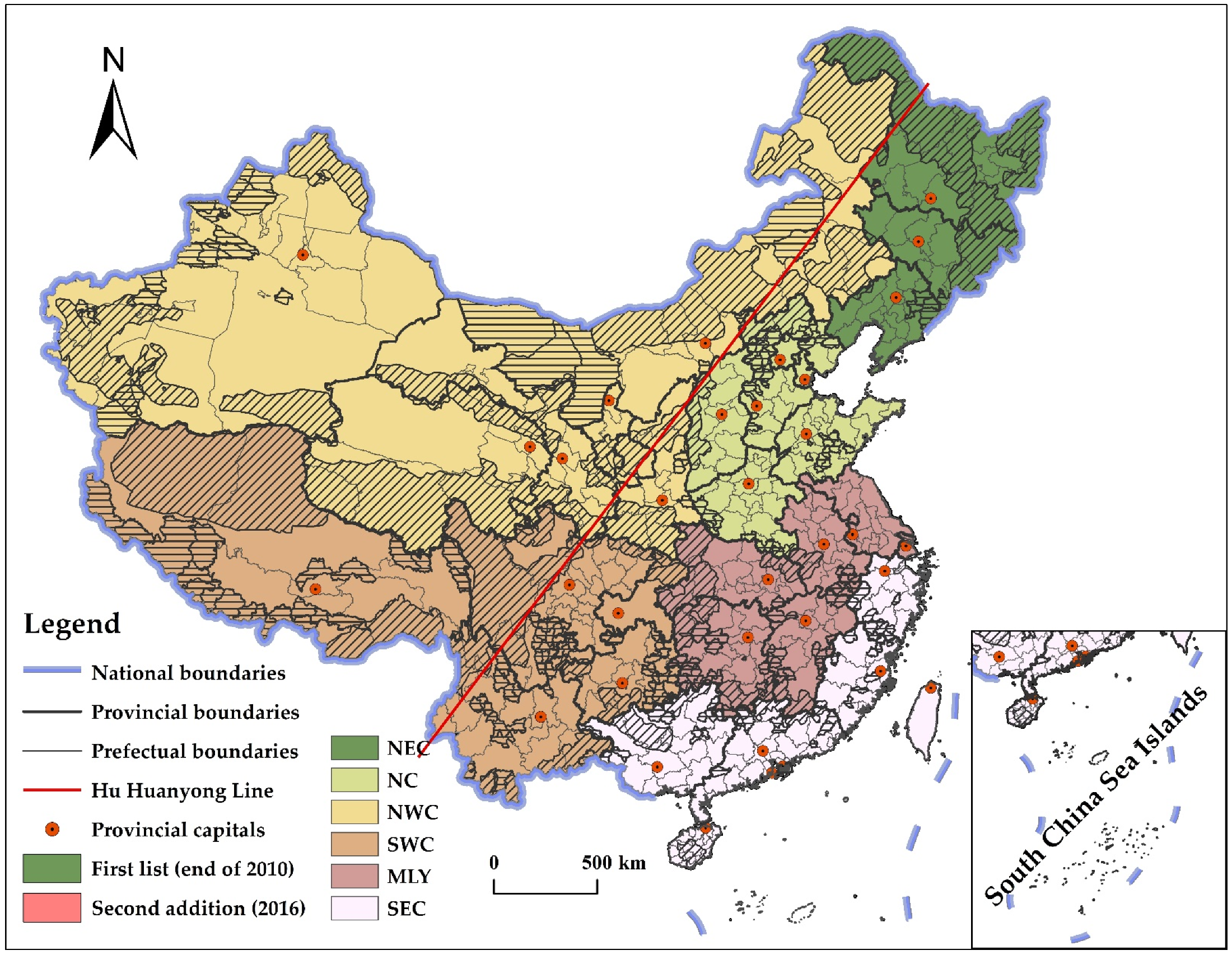
References
- Yu, Y.; Zhang, N. Low-carbon city pilot and carbon emission efficiency: Quasi-experimental evidence from China. Energy Econ. 2021, 96, 105125. [Google Scholar] [CrossRef]
- Ball, B.; Kominoski, J.S.; Adams, H.E.; Jones, S.E.; Kane, E.S.; Loecke, T.D.; Mahaney, W.M.; Martina, J.P.; Prather, C.M.; Robinson, T.M.P.; et al. Direct and terrestrial vegetation-mediated effects of environmental change on aquatic ecosystem processes. BioScience 2010, 60, 590. [Google Scholar] [CrossRef]
- Gao, Y.; He, N.; Wang, Y. Characteristics of carbon sequestration by ecosystem and progress in its research. J. Nat. Resour. 2013, 28, 1264–1274. [Google Scholar] [CrossRef]
- Lin, G.; Jiang, D.; Fu, J.; Cao, C.; Zhang, D. Spatial Conflict of Production–Living–Ecological Space and Sustainable-Development Scenario Simulation in Yangtze River Delta Agglomerations. Sustainability 2020, 12, 2175. [Google Scholar] [CrossRef]
- Liu, J.; Liu, Y.; Li, Y. Classification evaluation and spatial-temporal analysis of “production-living-ecological” spaces in China. Acta Geogr. Sin. 2017, 72, 1290–1304. [Google Scholar] [CrossRef]
- Xu, J.; Xie, G.; Xiao, Y.; Li, N.; Yu, F.; Pei, S.; Jiang, Y. Dynamic Analysis of Ecological Environment Quality Combined with Water Conservation Changes in National Key Ecological Function Areas in China. Sustainability 2018, 10, 1202. [Google Scholar] [CrossRef]
- Zhu, Y.; Chen, H. Did the transfer payment in key eco-functional areas improve the eco-environment? Based on PSM. South China J. Econ. 2020, 10, 125–140. [Google Scholar] [CrossRef]
- Liu, B.; Song, M. Basic framework and value realization of carbon sink ecological products. Nat. Resour. Econ. China 2022, 35, 4–11. [Google Scholar] [CrossRef]
- UNFCCC. Kyoto Protocol to the United Nations Framework Convention on Climate Change. International Law Documents; Cambridge University Press: Cambridge, UK, 2016; pp. 491–508. [Google Scholar] [CrossRef]
- Lin, S.; Qi, Y. The incentive effect and strategy choice of location-oriented ecological environmental policy. Public Financ. Res. 2021, 6, 85–103. [Google Scholar] [CrossRef]
- Pan, D.; Tang, J. The effects of heterogeneous environmental regulations on water pollution control: Quasi-natural experimental evidence from China. Sci. Total Environ. 2021, 751, 141550. [Google Scholar] [CrossRef]
- Zhang, W.; Li, G. Dynamic incentive effect analysis of transfer payment in national key ecological function zone. China Popul. Resour. Environ. 2015, 25, 125–131. [Google Scholar] [CrossRef]
- Fu, R.; Miao, X. A new financial transfer payment system in ecological function areas in China: Based on the spillover ecological value measured by the expansion energy analysis. Econ. Res. J. 2015, 50, 47–61. [Google Scholar]
- Li, G.; Li, X.; Wang, H. Ecological compensation effect of national key ecological function areas transfers payment policy. Mod. Econ. Sci. 2013, 35, 58–64. [Google Scholar]
- Li, G.; Li, X. Allocation mechanism of national key ecological function areas transfer payment. China Population. Resour. Environ. 2014, 24, 124–130. [Google Scholar] [CrossRef]
- Li, G.; Wang, H.; Liu, Q. The dual objectives and performance evaluation of transfer payment in national key ecological function areas. J. Northwest Univ. (Philos. Soc. Sci. Ed.) 2014, 44, 151–155. [Google Scholar] [CrossRef]
- Li, G.; Yang, L.; Liu, S. Study on spatial spillover effects of ecological environment quality at the county level in national key ecological function areas. J. China Univ. Geosci. (Soc. Sci. Ed.) 2016, 16, 10–19. [Google Scholar] [CrossRef]
- Xu, H.; Zhang, W. Study on the ecological protection effect of the transfer payment of national key ecological function areas: An empirical study based on Shaanxi data. China Population. Resour. Environ. 2017, 27, 141–148. [Google Scholar] [CrossRef]
- Miao, X.; Zhao, Y. Impact of transfer payment in eco-functional areas on eco-environmental improvement: Capital compensation or institutional incentives? Public Financ. Res. 2019, 5, 17–32. [Google Scholar] [CrossRef]
- Liu, L.; Cao, W.; Wu, D.; Huang, L. Temporal and spatial variations of ecosystem services in national key ecological function zones. Sci. Geogr. Sin. 2018, 38, 1508–1515. [Google Scholar] [CrossRef]
- Hou, P.; Zhai, J.; Cao, W.; Yang, M.; Cai, M.Y.; Li, J. Evaluation on ecosystem changes and protection of the national key ecological function zones in mountainous areas of central Hainan Island. Acta Geogr. Sin. 2018, 73, 429–441. [Google Scholar] [CrossRef]
- Xu, J.; Xie, G.; Xiao, Y.; Li, N.; Jiang, Y.; Chen, W. Dynamic analysis of ecological environmental quality changes in national key ecological function areas in China. Acta Ecol. Sin. 2019, 39, 3039–3050. [Google Scholar] [CrossRef]
- Liu, H.; Gao, J.; Liu, X.; Zhang, H.; Xu, X. Monitoring and assessment of the ecosystem services value in the national key ecological function zones. Acta Ecol. Sin. 2020, 40, 1865–1876. [Google Scholar] [CrossRef]
- Huang, X.; Chen, Y.; Zhao, Y.; Shi, M.; Li, T. Optimization on land spatial development pattern in the Yellow River Basin: From the perspective of land development intensity. Geogr. Res. 2021, 40, 1554–1564. [Google Scholar] [CrossRef]
- Jiang, H.; Chen, L. Spatial allocation efficiency and control strategy of county land resources based on main functional areas of territorial space: A case study of Ganyu, Jiangsu province. J. Nat. Resour. 2021, 36, 2424–2436. [Google Scholar] [CrossRef]
- DeFries, R.; Hansen, A.; Turner, B.; Reid, R.; Liu, J. Land use change around protected areas: Management to balance human needs and ecological function. Ecol. Appl. 2007, 17, 1031–1038. [Google Scholar] [CrossRef]
- Zhou, X.Y.; Lei, K.; Meng, W.; Khu, S.T. Industrial structural upgrading and spatial optimization based on water environment carrying capacity. J. Clean. Prod. 2017, 165, 1462–1472. [Google Scholar] [CrossRef]
- Yu, Y.; Sun, P.; Xuan, Y. Do constraints on local governments’ environmental targets affect industrial transformation and upgrading? Econ. Res. J. 2020, 55, 57–72. [Google Scholar]
- Luo, Z.; Qi, B. The effects of environmental regulation on industrial transfer and upgrading and banking synergetic development—Evidence from water pollution control in Yangtze River Basin. Econ. Res. J. 2021, 56, 174–189. [Google Scholar]
- Liu, Z.; Lin, Y. Structural transformation, TFP and high-quality development. Manag. World 2020, 36, 15–29. [Google Scholar] [CrossRef]
- Fan, J. Theoretical innovation in optimization of protection and development of China’s territorial space and coping strategy of 13th Five-Year Plan. Bull. Chin. Acad. Sci. 2016, 31, 1–12. [Google Scholar] [CrossRef]
- Rosenthal, S.; Strange, W. Geography, industrial organization, and agglomeration. Rev. Econ. Stat. 2003, 85, 377–393. [Google Scholar] [CrossRef]
- Wang, F.; Ge, X. Can low-carbon transition impact employment: Empirical evidence from Low-carbon city pilot policy. China Ind. Econ. 2022, 5, 81–99. [Google Scholar] [CrossRef]
- Pan, D. The impact of command-and-control and market-based environmental regulations on afforestation area: Quasi- natural experimental evidence from county data in China. Resour. Sci. 2021, 43, 2026–2041. [Google Scholar] [CrossRef]
- Zhang, W.; Li, J.; Li, G.; Guo, S. Emission reduction effect and carbon market efficiency of carbon emissions trading policy in China. Energy 2020, 196, 117117. [Google Scholar] [CrossRef]
- Wu, Y.; Qi, J.; Xian, Q.; Wu, J.D. The carbon emission reduction effect of China’s carbon market-From the perspective of the coordination between market mechanism and administrative intervention. China Ind. Econ. 2021, 8, 114–132. [Google Scholar] [CrossRef]
- Mcgavock, T. Here waits the bride? The effect of Ethiopia’s child marriage law. J. Dev. Econ. 2021, 149, 102580. [Google Scholar] [CrossRef]
- Tao, F.; Zhao, J.; Zhou, H. Does environmental regulation improve the quantity and quality of green innovation----Evidence from the target responsibility system of environmental protection. China Ind. Econ. 2021, 2, 136–154. [Google Scholar] [CrossRef]
- Chen, S. The effect of a fiscal squeeze on tax enforcement: Evidence from a natural experiment in China. J. Public Econ. 2017, 147, 62–76. [Google Scholar] [CrossRef]
- He, Q.; Chen, Z.; Peng, X.; Liu, Y.; Zhang, M. An assessment of forest biomass carbon storage and ecological compensation based on surface area: A case study of Hubei province, China. Ecol. Indic. 2018, 90, 392–400. [Google Scholar] [CrossRef]
- Chen, J.; Fan, W.; Li, D.; Liu, X.; Song, M. Driving factors of global carbon footprint pressure: Based on vegetation carbon sequestration. Appl. Energy 2020, 267, 114914. [Google Scholar] [CrossRef]
- Cisilino, F.; Bodini, A.; Zanoli, A. Rural development programs’ impact on environment: An ex-post evaluation of organic farming. Land Use Policy 2019, 85, 454–462. [Google Scholar] [CrossRef]
- Li, P.; Lu, Y.; Wang, J. Does flattening government improve economic performance? Evidence from China. J. Dev. Econ. 2016, 123, 18–37. [Google Scholar] [CrossRef]
- Lu, S.; Dong, R.; Ye, C. Does “the Belt and Road Initiative” promote high-quality exports—Evidence from firms in China. China Ind. Econ. 2021, 3, 80–98. [Google Scholar] [CrossRef]
- Shi, D.; Ding, H.; Wei, P.; Liu, J. Can smart city construction reduce environmental pollution? China Ind. Econ. 2018, 6, 117–135. [Google Scholar] [CrossRef]
- Yu, B. Economic growth effects of industrial restructuring and productivity improvement-Analysis of dynamic spatial panel model with Chinese city Data. China Ind. Econ. 2015, 12, 83–98. [Google Scholar] [CrossRef]
- Wang, X.; Gao, Y. The road to rural revitalization in poor counties in national key ecological function areas. Probe 2018, 4, 94–100. [Google Scholar] [CrossRef]
- Tang, K.; Qiu, Y.; Zhou, D. Does command-and-control regulation promote green innovation performance? Evidence from China’s industrial enterprises. Sci. Total Environ. 2020, 712, 136362. [Google Scholar] [CrossRef]
- Liu, W.; Liu, J.; Kuang, W.; Ning, J. Examining the influence of the implementation of Major Function-oriented Zones on built-up area expansion in China. J. Geogr. Sci. 2017, 27, 643–660. [Google Scholar] [CrossRef]
- Yang, F.; Huang, J.; He, Q.; Zheng, X.; Zhou, C.; Pan, H.; Huo, W.; Yu, H.; Liu, X.; Meng, L.; et al. Impact of differences in soil temperature on the desert carbon sink. Geoderma 2020, 379, 114636. [Google Scholar] [CrossRef]
- Clarke, D. Estimating Difference-in-Differences in the Presence of Spillovers; MPRA Paper: Munich, Germany, 2017; p. 81604. [Google Scholar]
- Fan, Y.; Zhu, Q.; Liu, J. Tax information disclosure, tax avoidance and spillover effect: Evidence from country-by country reporting. Financ. Trade Econ. 2022, 43, 21–36. [Google Scholar] [CrossRef]
- Mao, J.; Lv, B.; Ma, G. The transfer payment and the government expansion: A study based on “the Price Effect”. Manag. World 2015, 7, 29–41+187. [Google Scholar] [CrossRef]
- Ding, F.; Zhuang, G. Has the establishment of National Key Ecological Function Areas promoted economic development? Evaluation of the policy effects based on a DID study. China Popul. Resour. Environ. 2021, 31, 19–28. [Google Scholar] [CrossRef]
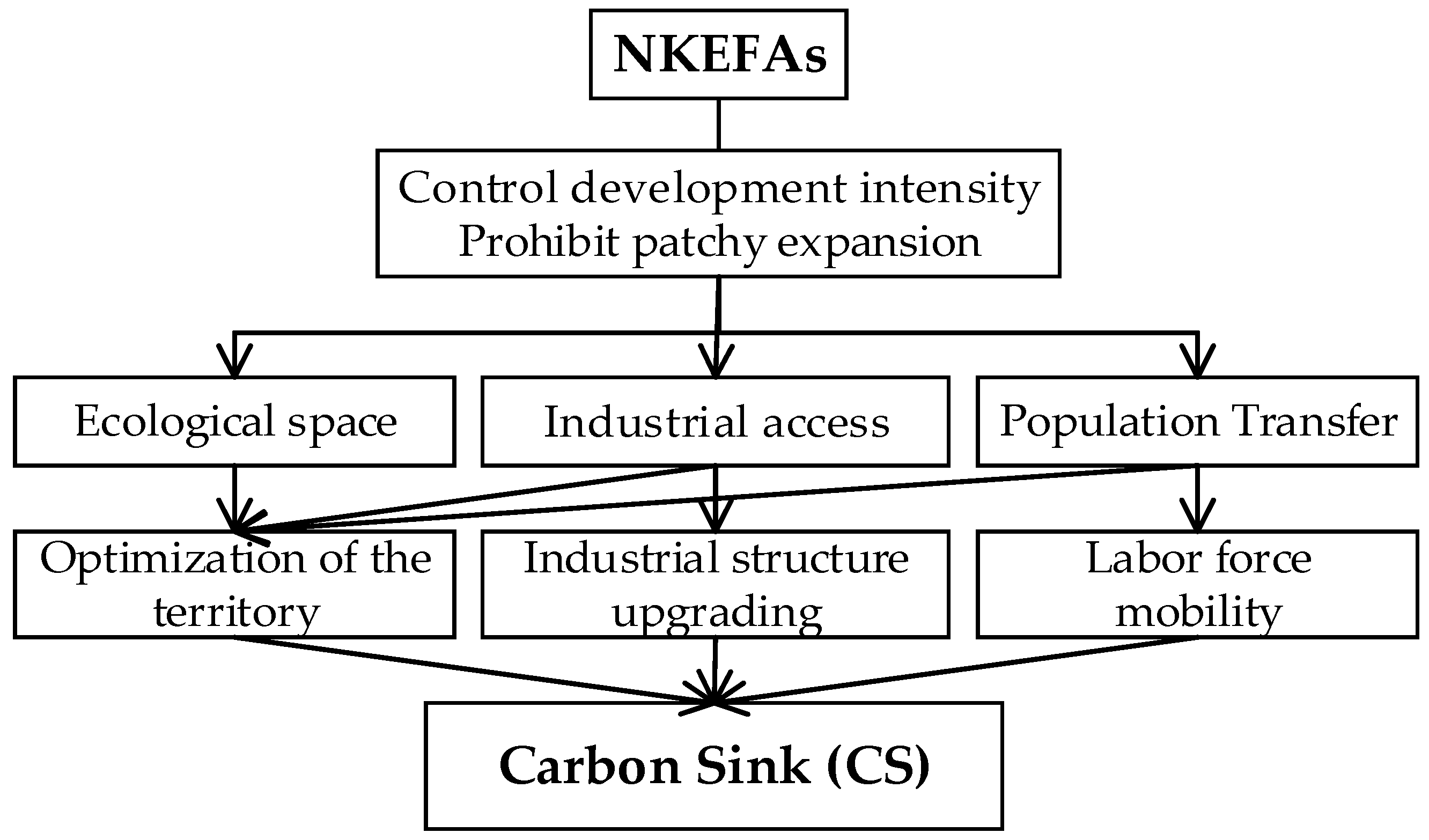
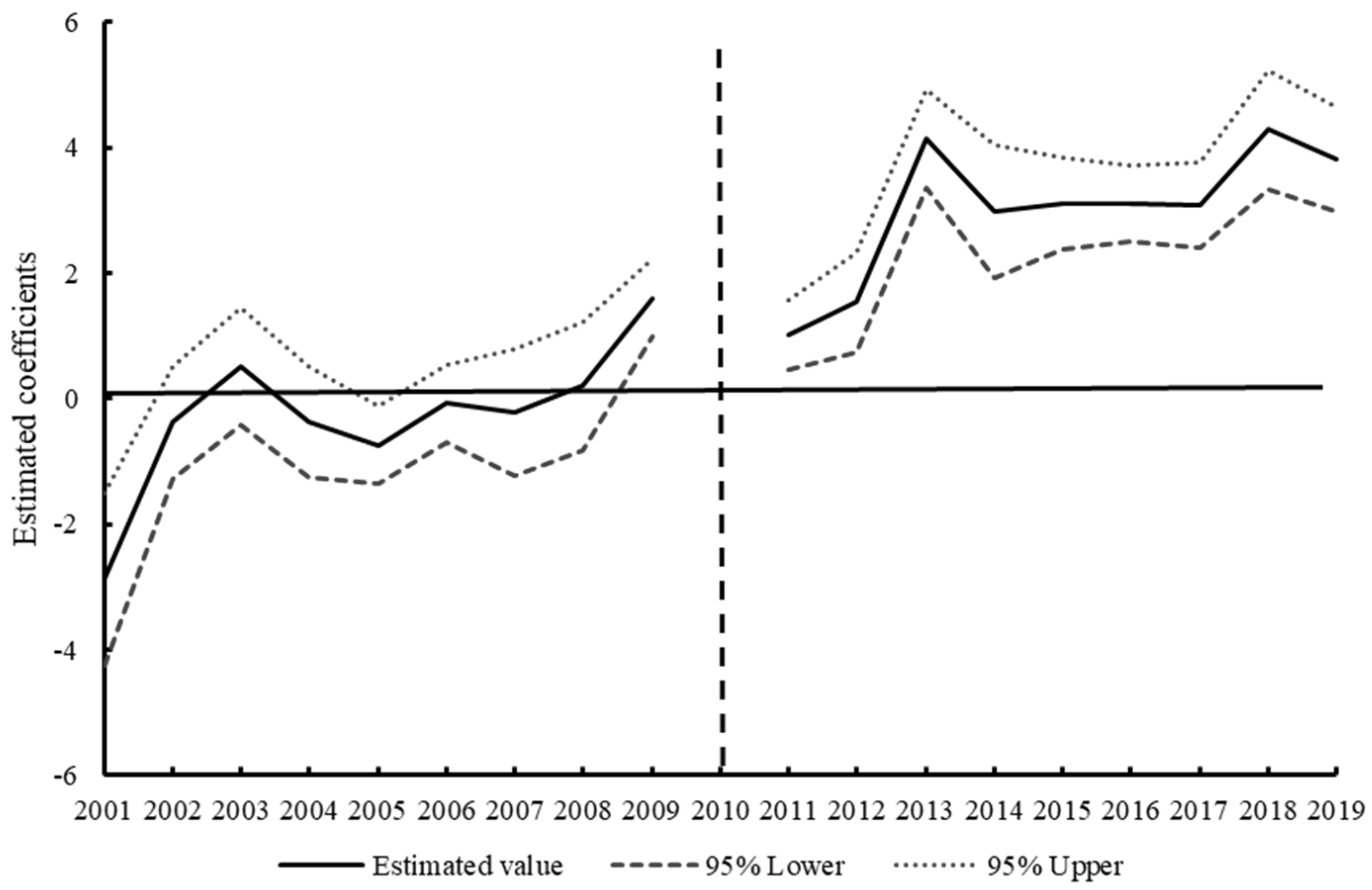
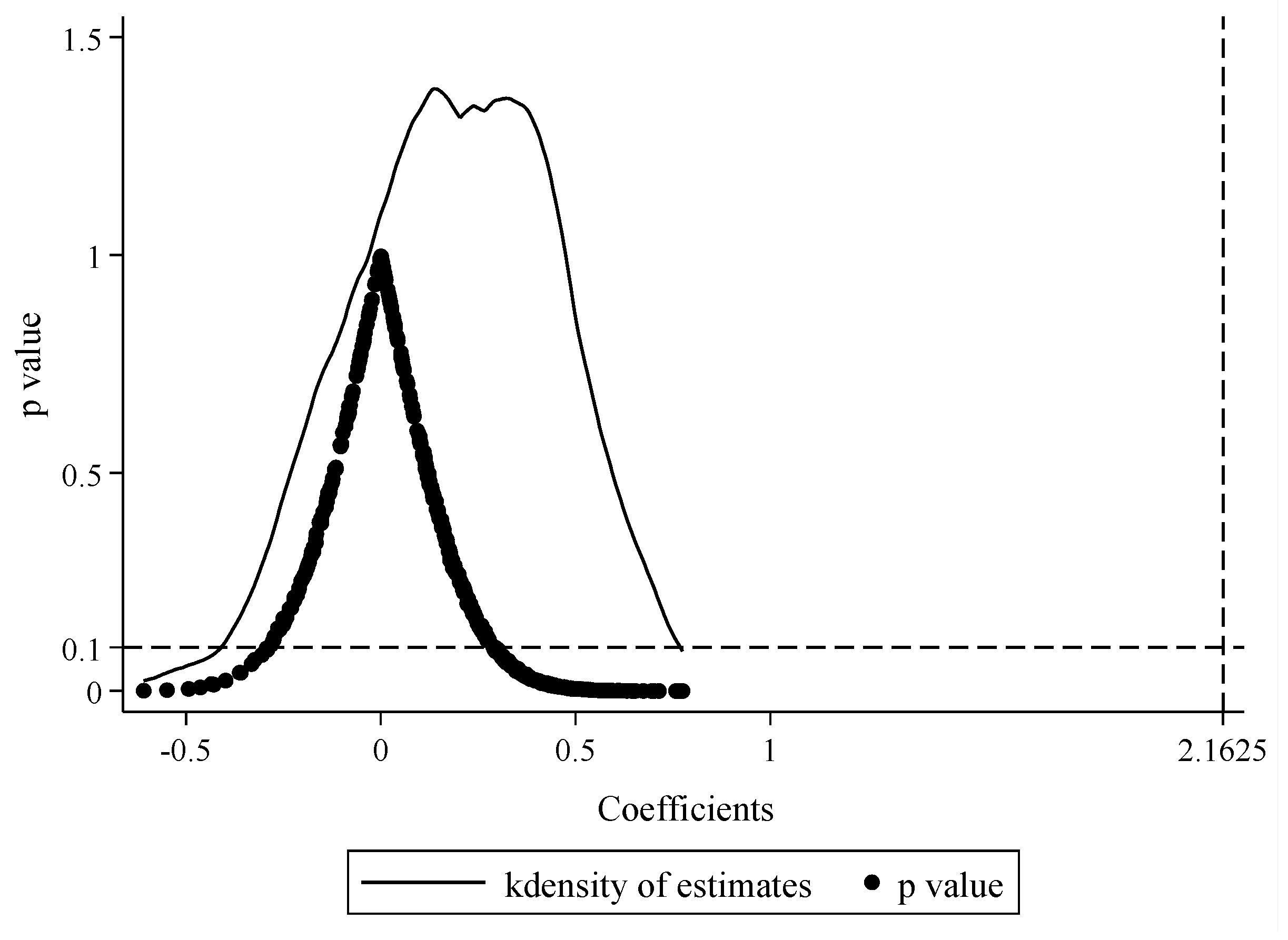
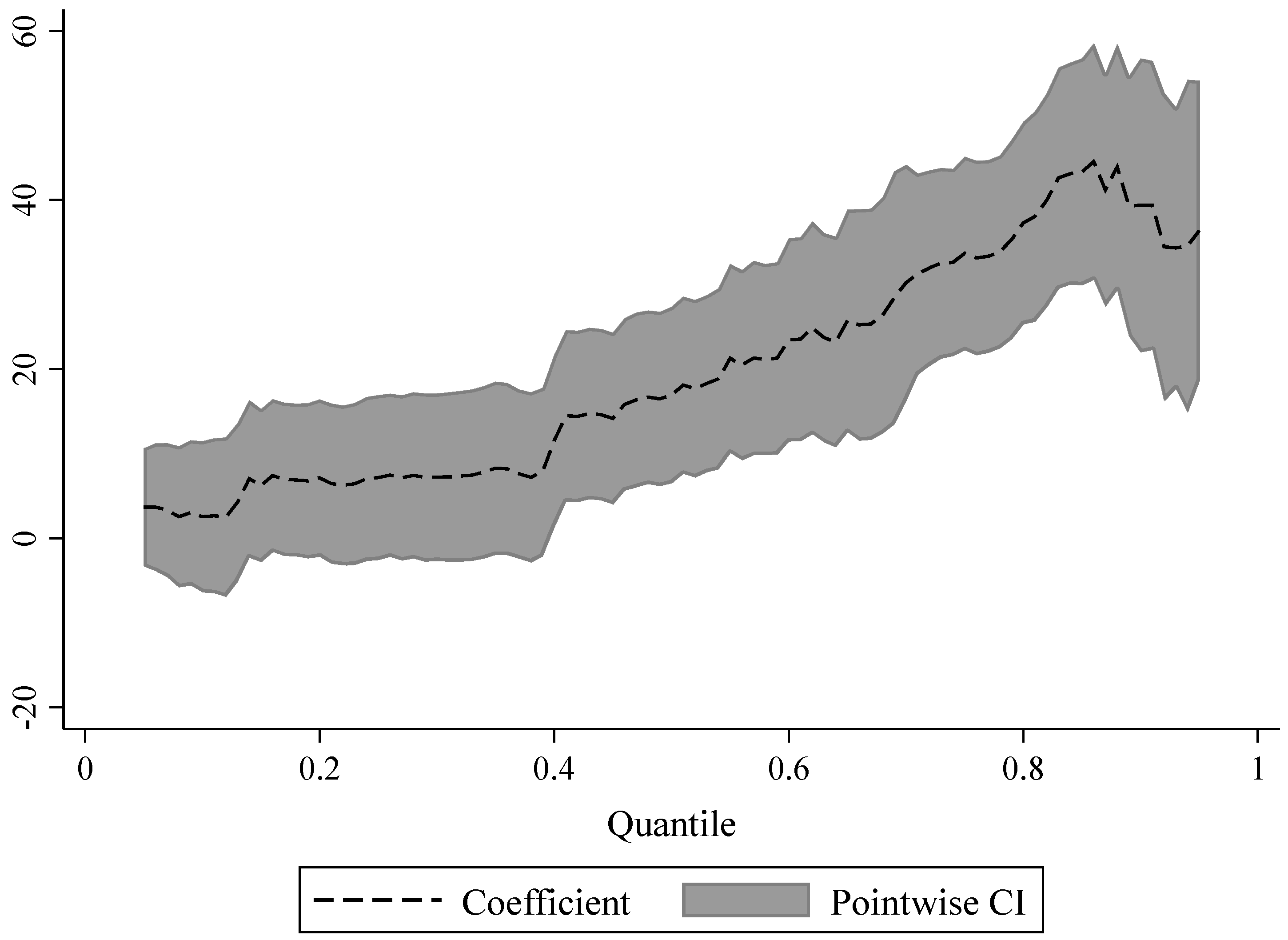
| Variable | Variable Definition | N | Mean | S.D. | Min. | Max. |
|---|---|---|---|---|---|---|
| Explained variables: | ||||||
| CS | Vegetation carbon sink scale (million tons) | 6270 | 31.734 | 35.868 | 0.061 | 430.523 |
| Core explanatory variable: | ||||||
| DID | NKEFAs | 6270 | 0.198 | 0.398 | 0 | 1 |
| Control variables: | ||||||
| DEN | Total population/land area (people/km2) | 6270 | 402.861 | 485.234 | 0.656 | 6729.490 |
| lnPGDP | Logarithm of GDP per capita (2001 as base period)/RMB yuan | 6270 | 10.010 | 0.937 | 6.898 | 12.657 |
| URBAN | Urbanization rate of resident population/% | 6270 | 42.574 | 19.694 | 7.435 | 100 |
| STRUC | Gross secondary industry/GDP | 6270 | 0.384 | 0.094 | 0.086 | 0.835 |
| GAP | Urban per capita disposable income/rural per capita net income | 6270 | 2.685 | 0.784 | 0.917 | 7.378 |
| OPEN | Total import and export trade/GDP | 6270 | 0.187 | 0.375 | 0 | 6.966 |
| TRANS | Road mileage/land area (km/km2) | 6270 | 0.801 | 0.559 | 0.009 | 5.887 |
| PRE | Average annual precipitation/mm | 6270 | 954.358 | 539.161 | 29.289 | 2680.360 |
| TEM | Average annual temperature/°C | 6270 | 13.883 | 5.451 | −2.908 | 25.636 |
| SUN | Sunshine hours/h | 6270 | 2068.952 | 511.408 | 784.640 | 3407.62 |
| Variables | Explained Variable: CS | |||
|---|---|---|---|---|
| (1) | (2) | (3) | (4) | |
| DID | 3.5388 *** (0.1333) | 2.3985 *** (0.1683) | 2.1615 *** (0.1678) | 2.1625 *** (0.1743) |
| DEN | — | — | −0.0016 *** (0.0006) | −0.0011 * (0.0005) |
| lnPGDP | — | — | 1.4101 *** (0.1239) | 1.2165 *** (0.2812) |
| URBAN | — | — | −0.0116 * (0.0064) | −0.0110 * (0.0064) |
| STRUC | — | — | 0.7183 (0.7941) | −0.4380 (0.9840) |
| GAP | — | — | 0.0328 (0.1280) | −0.0780 (0.1319) |
| OPEN | — | — | −0.5821 ** (0.2889) | −0.4847 * (0.2906) |
| TRANS | — | — | −0.5008 ** (0.2069) | −0.4486 ** (0.2149) |
| PRE | — | — | 0.0007 *** (0.0002) | 0.0006 *** (0.0002) |
| TEM | — | — | −0.0327(0.0764) | −0.2245 ** (0.0871) |
| SUN | — | — | −0.0004 * (0.0002) | −0.0005 * (0.0003) |
| Constant | 31.6003 *** (1.7518) | 28.6806 *** (0.1896) | 19.6504 *** (2.3671) | 25.4192 *** (2.9588) |
| Adj-R2 | 0.1062 | 0.1582 | 0.1424 | 0.1688 |
| city FE | NO | YES | NO | YES |
| year FE | NO | YES | NO | YES |
| No. of cities | 330 | 330 | 330 | 330 |
| Variables | PSM-DID | Excluding Other Policy Interference | Substituting Explained Variables | Eliminating Special Samples |
|---|---|---|---|---|
| CS | CS | NDVI | CS | |
| (1) | (2) | (3) | (4) | |
| DID | 2.2004 *** (0.0043) | 2.1679 *** (0.1781) | 0.0185 *** (0.0011) | 1.9909 *** (0.1895) |
| Constant | 27.1356 *** (3.2617) | 25.4126 *** (2.9581) | 0.6039 *** (0.0195) | 21.2040 *** (3.1719) |
| Controls | Yes | Yes | Yes | Yes |
| Adj-R2 | 0.1757 | 0.1696 | 0.4931 | 0.1692 |
| city FE | Yes | Yes | Yes | Yes |
| year FE | Yes | Yes | Yes | Yes |
| No. of cities | 330 | 330 | 330 | 292 |
| Variables | TERRI | INDUS | LABOR | |||
|---|---|---|---|---|---|---|
| TERRI | CS | INDUS | CS | LABOR | CS | |
| (1) | (2) | (3) | (4) | (5) | (6) | |
| DID | 0.0025 *** (0.0003) | 2.0658 *** (0.1753) | 0.0121 * (0.0065) | 2.1437 *** (0.1737) | 0.0070 *** (0.0013) | 2.1128 *** (0.1745) |
| TERRI | 38.1633 *** (8.4921) | |||||
| INDUS | 1.5487 *** (0.2341) | |||||
| LABOR | 7.0843 *** (1.7342) | |||||
| Constant | 0.4885 *** (0.0045) | 6.7750 (5.0929) | 0.3239 ** (0.1638) | 24.9176 *** (2.9491) | 0.2968 *** (0.0222) | 23.3168 *** (2.9993) |
| Controls | Yes | Yes | Yes | Yes | Yes | Yes |
| Adj-R2 | 0.3338 | 0.1716 | 0.6547 | 0.3345 | 0.3305 | 0.1711 |
| city FE | Yes | Yes | Yes | Yes | Yes | Yes |
| year FE | Yes | Yes | Yes | Yes | Yes | Yes |
| No. of cities | 330 | 330 | 330 | 330 | 330 | 330 |
| Variables | Water Conservation | Soil Conservation | Windbreak Sand-Fixation | Biodiversity Maintenance |
|---|---|---|---|---|
| (1) | (2) | (3) | (4) | |
| DID | 1.1967 *** (0.2137) | 2.0411 *** (0.2815) | 7.7708 *** (0.3853) | 0.6964 *** (0.2543) |
| Constant | 22.4709 *** (2.9962) | 26.7325 *** (3.0078) | 25.1438 *** (2.8970) | 24.2242 *** (2.9958) |
| Controls | Yes | Yes | Yes | Yes |
| Adj-R2 | 0.1516 | 0.1546 | 0.2020 | 0.1482 |
| city FE | Yes | Yes | Yes | Yes |
| year FE | Yes | Yes | Yes | Yes |
| No. of NKEFAs | 95 | 40 | 18 | 52 |
| No. of cities | 330 | 330 | 330 | 330 |
| Variables | NEC | NC | NWC | SWC | MLY | SEC | West side | East side |
|---|---|---|---|---|---|---|---|---|
| (1) | (2) | (3) | (4) | (5) | (6) | (7) | (8) | |
| DID | 2.4679 *** (0.4665) | 2.0233 *** (0.2149) | 3.7120 *** (0.7461) | 0.7847 * (0.4041) | 0.5737 *** (0.1501) | 0.6091 *** (0.2186) | 3.0197 *** (0.9017) | 1.7315 *** (0.1332) |
| Constant | 41.7258 *** (9.8409) | 26.0882 *** (4.9821) | 16.5328 *** (10.7054) | 53.7831 *** (8.1748) | 28.3889 *** (3.5909) | 38.7921 *** (4.5361) | 13.9183 *** (11.7277) | 29.7897 *** (2.3952) |
| Controls | Yes | Yes | Yes | Yes | Yes | Yes | Yes | Yes |
| Adj-R2 | 0.3559 | 0.5711 | 0.2611 | 0.3891 | 0.3576 | 0.2888 | 0.1944 | 0.2338 |
| city FE | Yes | Yes | Yes | Yes | Yes | Yes | Yes | Yes |
| year FE | Yes | Yes | Yes | Yes | Yes | Yes | Yes | Yes |
| No. of cities | 36 | 59 | 63 | 47 | 67 | 58 | 57 | 273 |
| Quantile | DID | Controls | City FE | Year FE | No. of Cities | |
|---|---|---|---|---|---|---|
| (1) | 0.05 | 4.2911 *** (0.1783) | Yes | Yes | Yes | 330 |
| (2) | 0.25 | 6.0542 *** (0.1052) | Yes | Yes | Yes | 330 |
| (3) | 0.50 | 17.4855 *** (0.2128) | Yes | Yes | Yes | 330 |
| (4) | 0.75 | 35.0966 *** (0.2275) | Yes | Yes | Yes | 330 |
| (5) | 0.95 | 16.5249 *** (1.1962) | Yes | Yes | Yes | 330 |
| Variables | Ecological Spillover Effect | Economic Growth | ||
|---|---|---|---|---|
| CS | CS | lnGDP | lnPGDP | |
| (1) | (2) | (3) | (4) | |
| DID | 2.6682 *** (0.4691) | 2.4188 *** (0.4395) | 0.0299 *** (0.0082) | 0.0491 *** (0.0084) |
| Spillover effect | 0.5395 *** (0.1644) | 0.4858 *** (0.1656) | ||
| Constant | 28.6401 *** (0.3257) | 22.7182 *** (5.2892) | 5.7650 *** (0.0704) | 9.5025 *** (0.0712) |
| Controls | No | Yes | Yes | Yes |
| Adj-R2 | 0.1606 | 0.1700 | 0.0299 | 0.9498 |
| city FE | Yes | Yes | Yes | Yes |
| year FE | Yes | Yes | Yes | Yes |
| No. of cities | 330 | 330 | 330 | 330 |
Publisher’s Note: MDPI stays neutral with regard to jurisdictional claims in published maps and institutional affiliations. |
© 2022 by the authors. Licensee MDPI, Basel, Switzerland. This article is an open access article distributed under the terms and conditions of the Creative Commons Attribution (CC BY) license (https://creativecommons.org/licenses/by/4.0/).
Share and Cite
Zhang, T.; Hou, M.; Chu, L.; Wang, L. Can the Establishment of National Key Ecological Function Areas Enhance Vegetation Carbon Sink? A Quasi-Natural Experiment Evidence from China. Int. J. Environ. Res. Public Health 2022, 19, 12215. https://doi.org/10.3390/ijerph191912215
Zhang T, Hou M, Chu L, Wang L. Can the Establishment of National Key Ecological Function Areas Enhance Vegetation Carbon Sink? A Quasi-Natural Experiment Evidence from China. International Journal of Environmental Research and Public Health. 2022; 19(19):12215. https://doi.org/10.3390/ijerph191912215
Chicago/Turabian StyleZhang, Tongyue, Mengyang Hou, Liqi Chu, and Lili Wang. 2022. "Can the Establishment of National Key Ecological Function Areas Enhance Vegetation Carbon Sink? A Quasi-Natural Experiment Evidence from China" International Journal of Environmental Research and Public Health 19, no. 19: 12215. https://doi.org/10.3390/ijerph191912215
APA StyleZhang, T., Hou, M., Chu, L., & Wang, L. (2022). Can the Establishment of National Key Ecological Function Areas Enhance Vegetation Carbon Sink? A Quasi-Natural Experiment Evidence from China. International Journal of Environmental Research and Public Health, 19(19), 12215. https://doi.org/10.3390/ijerph191912215








